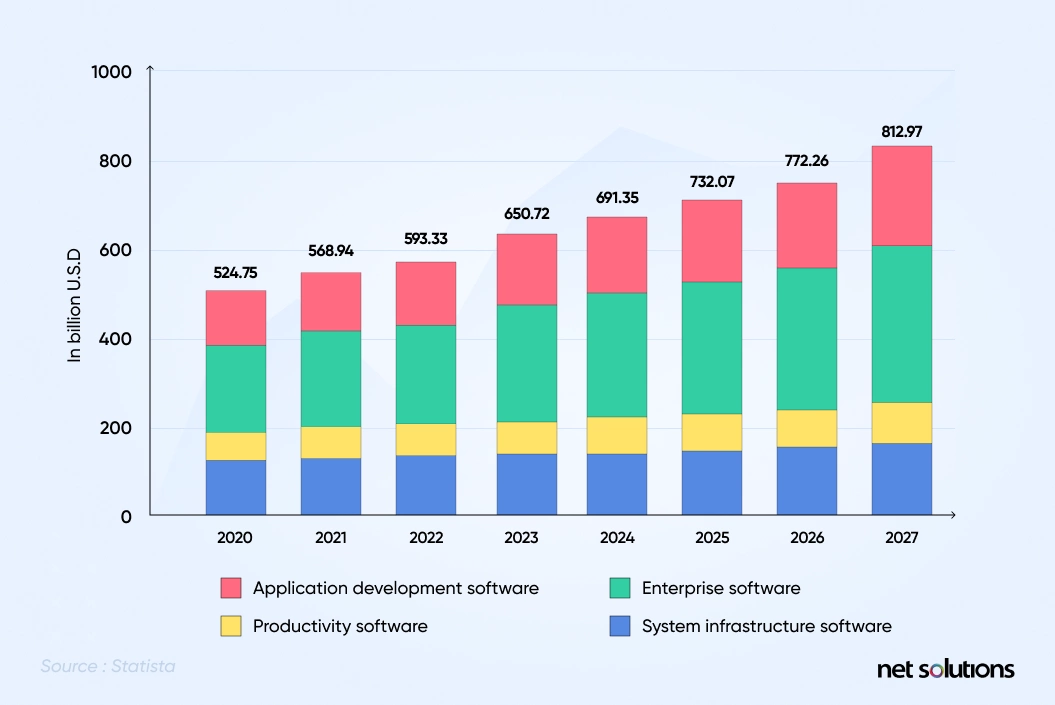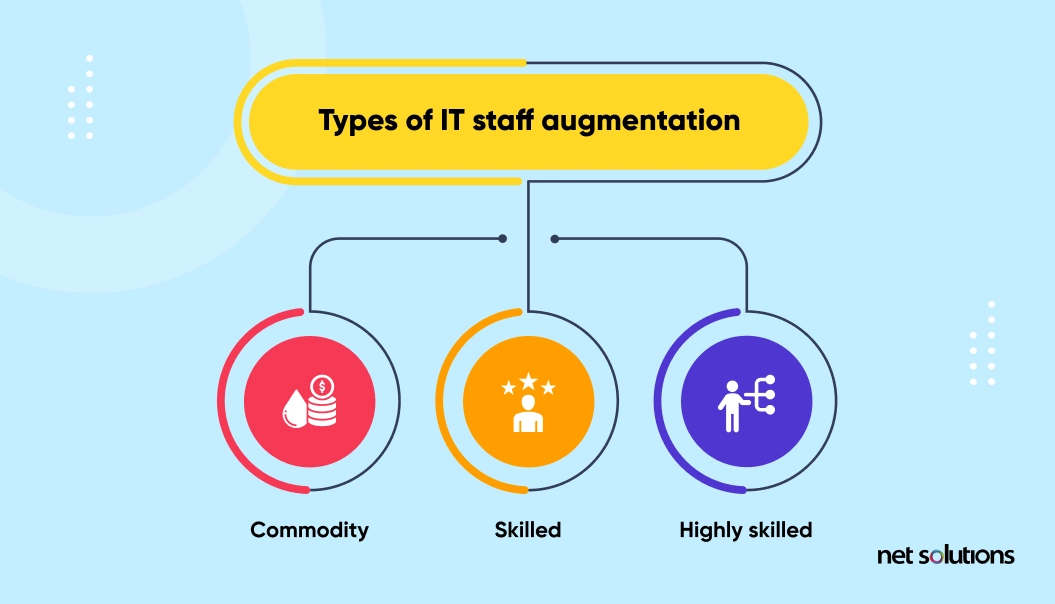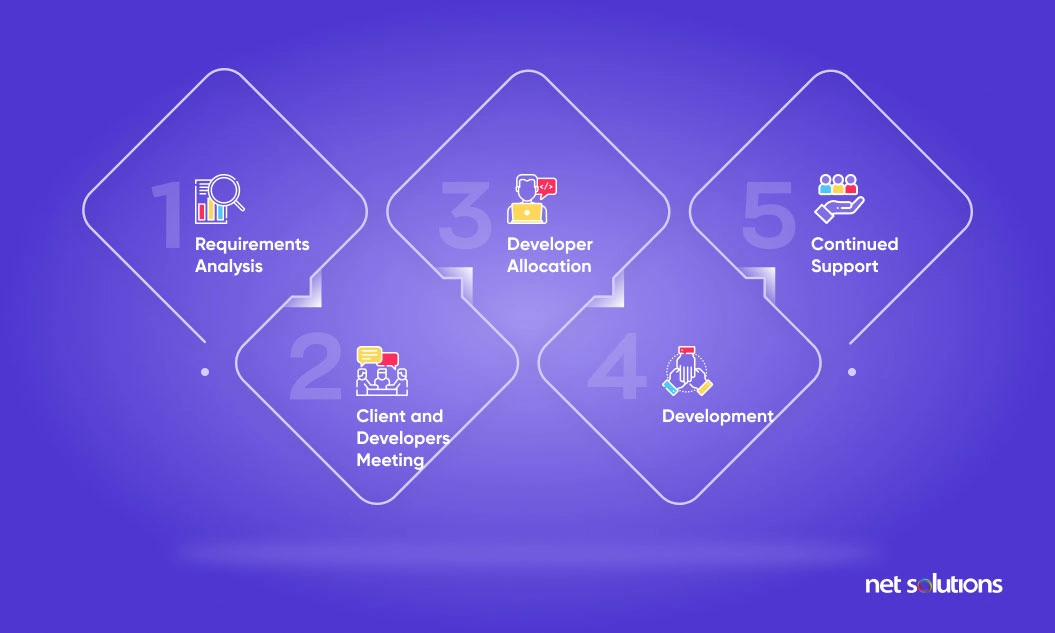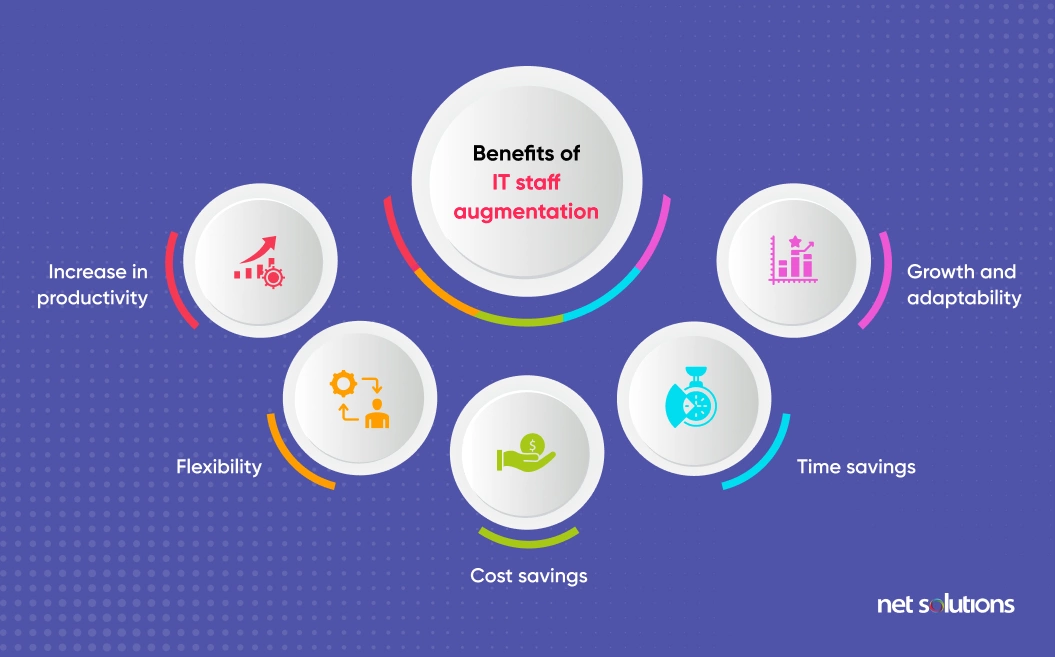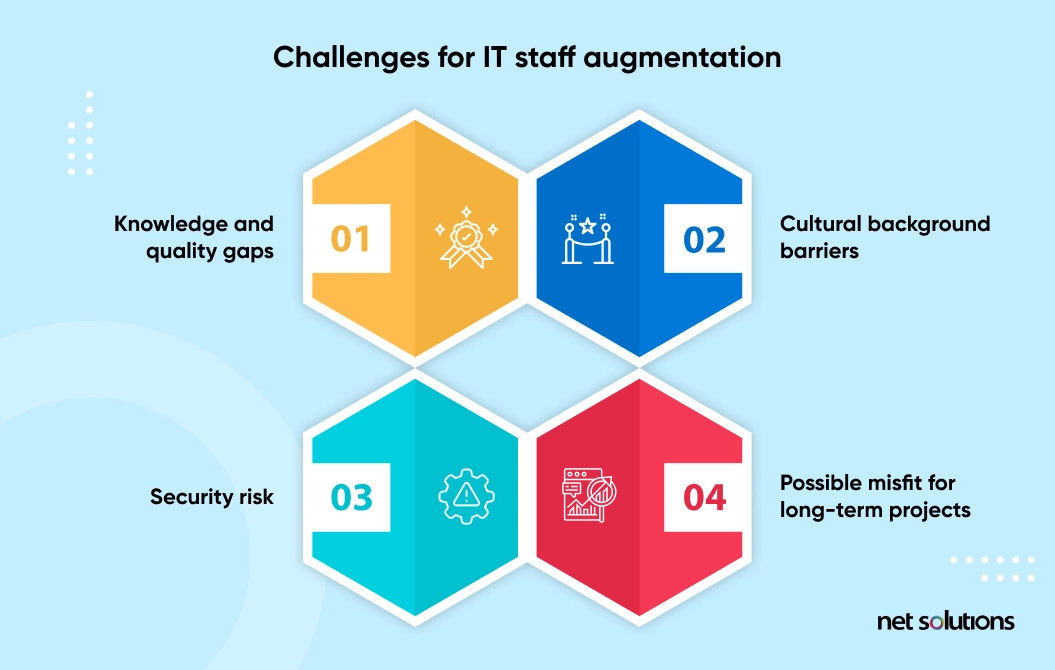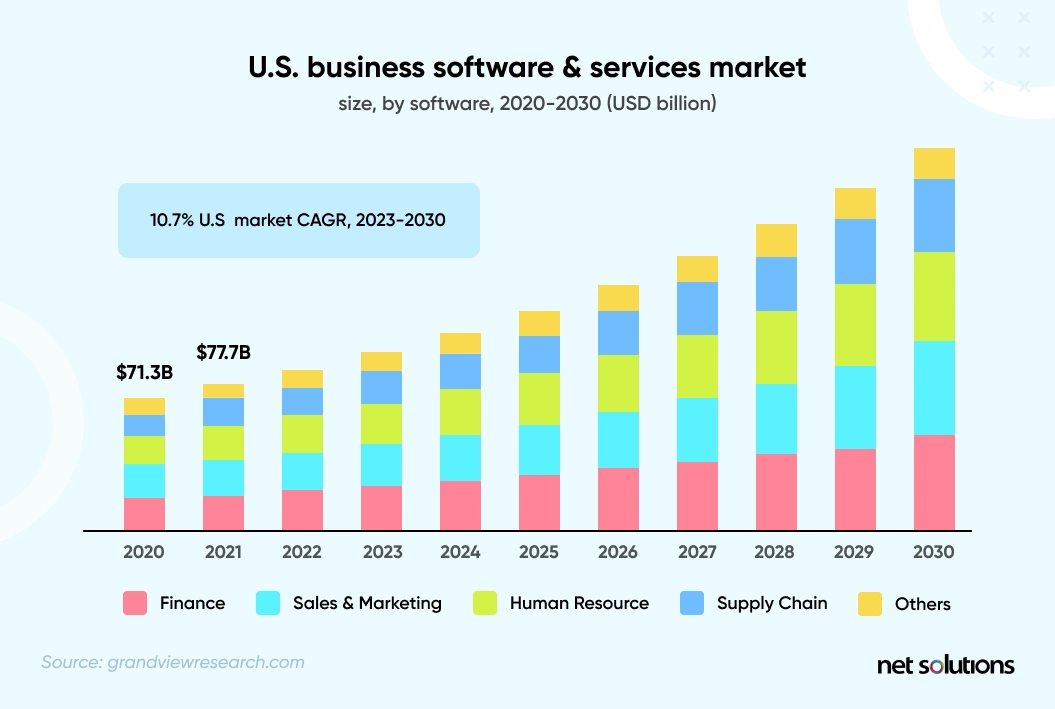Summary: What do you do when your business needs to perform on its IT projects but needs more staff? You seek help from temporary team members that can work in short-term job positions in the company. Outsourced teams, in the form of IT staff augmentation, are potent resources for an organization. Here’s our take on the concept and how to make the best of it.
Due to the team’s lack of tech talent, businesses often find it challenging to meet the project objectives (timely and quality delivery). Hiring permanent staff can be a lengthy process, which, in turn, can further hamper the delivery timelines. A safe way to counter the challenge is to fill the talent gap by hiring experienced personnel on a temporary/project basis. The process is called IT staff augmentation and is similar to borrowing an expert from agencies that facilitate software development outsourcing.
The software market has seen phenomenal growth in recent years. As per Statista,
- Revenue in the Software market is projected to reach US$650.70 billion in 2023.
- Enterprise Software is the largest segment, with a projected market volume of US$263.80 billion in 2023.
- Revenue is expected to show an annual growth rate (CAGR 2023-2027) of 5.72%, resulting in a market volume of US$812.90 billion by 2027.
- In global comparison, the most significant share of the revenue will be generated in the United States (US$321.60 billion in 2023).
A booming software market brings about an increase in demand for varied skill sets and trained staff. The following break-up shows how the software market is expected to show a surge in revenue:
With increasing demands for trained staff, IT staff augmentation has become imperative. Here’s a guide to help you get started on your journey.
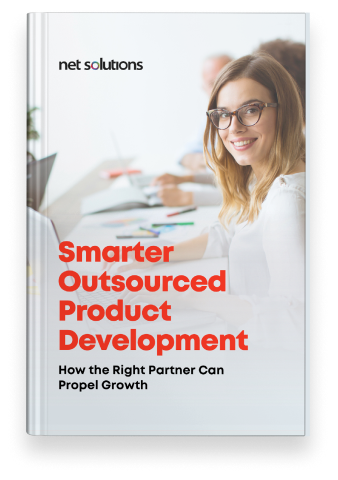
We respect your privacy. Your information is safe.
What is IT Staff Augmentation?
As a broad concept, staff augmentation involves temporarily outsourcing staff from an outside organization to complete a project. The practice is commonly used in IT projects to meet the requirements of a product development initiative. Hence ‘IT staff augmentation’ is a term that has become a part of every tech organization’s lexicon.
While in the case of software development outsourcing, you hand over the entire task to an outside agency. However, in staff augmentation, you cherry-pick skilled personnel from outsourcing companies to complete a project your in-house team is currently working on.
Software development services demand immense research to achieve the project goals. However, tech teams can often lack the desired skills and competence. There could be a general shortage of skills in the market, a need for highly trained and specialized skill sets, or a high attrition rate in the particular industry. IT staff augmentation facilitates faster scaling. Finding developers, architects, test engineers, business analysts, project managers, or other specialists becomes more convenient. IT staff augmentation lets you hire “highly skilled” developers with expertise in the tech stack you are working with.
Staff augmentation services allow you to leverage the best of both worlds, i.e., your squad consists of your in-house team and some of the best professionals from outside agencies whom you hire on a contractual basis.
With remote work turning out to be the new normal, the IT staff augmentation trend is on the rise as it allows organizations to augment staff from anywhere in the world.
IT Staff Augmentation vs. Managed Services
When choosing a suitable operating model for your IT projects, getting confused between IT staff augmentation and managed services is expected.
Here’s a comparison table to help you answer — what is the difference between IT staff augmentation and managed services:
| IT Staff Augmentation (Out-Tasking) | Managed Services (Outsourcing) |
|---|---|
| Hiring developers from a software development company who work alongside the in-house team to complete the software project | Hiring an outside organization (outsourcing) to complete the entire software project |
| Focuses on delivering an input (additional staff) | Focuses on delivering an output (quality delivery) |
| Provides additional developers | Provides the entire development team, i.e., developers, business analysts, designers, testers, project manager, and quality analysts |
| Pricing depends on hours worked and availability | Pricing depends on service level agreements and final output |
| Performance-driven, i.e., the borrowed staff needs to match the specific skill set and the performance level of the existing team | Value-driven, i.e., the outsourced agency is liable to deliver an outcome regarding SLA |
| You will have to maintain the infrastructure to manage the development team. | You outsource entirely, so you do not have to maintain any infrastructure. You can focus on core operations while the managed service provider takes care of everything. |
| You will have to train the augmented staff to help them blend in. | No training is required as the entire project is taken care of by the provider |
| Control lies in your hands. | The full control of the project lies with the managed services provider |
Why Consider IT Staff Augmentation?
The post-pandemic times have seen the skilled staff shortage getting real. Where the hiring process for a permanent role is lengthy, finding the right people for the job can get even more challenging.
Implementing a staff augmentation strategy is an intelligent move to solve the staffing problem temporarily. On the one hand, you have the best in-house team. On the other hand, you can hire the best-experienced professionals on a contractual basis to solve the problem.
Here’s when you should consider staff augmentation for your IT project:
| Reason | Fulfills Needs |
|---|---|
| Increase Developer Capacity |
Meet delivery timelines Increase sprint velocity Maintain sustainable pace |
| Fulfill short-term Requirements |
Allows time to hire full-time employees Help meet the project requirements temporarily Helps ensure faster time to market |
| Bridge Skill Gap |
Access to staff that holds experience in a disruptive technology Meet the project timelines when permanent hiring is taking time Promote swarming (developers with appropriate skills work together to complete a task that is causing troubles) |
| Build Flexible Work Models |
Adopt the best-in-class business strategy Maintain competitive advantage Emerge as an agile organization |
When to Choose IT Staff Augmentation: Checklist
IT Staff augmentation is the right choice for your business if:
- If you have an in-house development team and you wish to extend its strength
- Permanent hiring is posing to be a challenge owing to talent or experience shortage
- You are planning to hire offshore talent to save costs and want to build a remote team culture
- You are looking for experienced developers who have experience with the disruptive technology you are working on
Types of IT Staff Augmentation
- Basic staffing service– the basic level yet trustworthy workers who can be without a particular skill set.
- Skills-based staffing service– the workers you need for specialized services, meaning they need to be trained especially for those tasks e:g, excel knowledge or data processing skills.
- Highly experienced staffing service– workers need to be highly trained in advanced skills and possess the advantage of experience.
IT Staff Augmentation Process Flow (What we Follow)
As a standard practice, the staff augmentation process follows through the following steps to ensure project success:
1. Requirements Analysis
The business and the functional requirements regarding the project are discussed. After thoroughly analyzing the requirements, we arrange a meeting between the developers and the client.
2. Client and Developers Meeting
A meeting is arranged between the client and the developers so that they are on the same page in context with the project requirements and the respective KRA (key responsibility area).
3. Developer/s Allocation
Once the requirements are precise, developer/s (one or multiple) are assigned to the project based on the client’s needs. The service provider usually does this allocation based on skills, experience, and availability.
4. Develop
The assigned developers collaborate with the in-house team to complete the tasks across the sprint cycles. The developer/s communicates with the client directly without the involvement of a project manager or a business analyst (unless a PM or a BA are also hired).
5. Continued Support
The hired developers continue to offer support throughout the product’s lifetime. If the hiring agency is satisfied with the work, they can employ the same team for other projects in the future.
What are the Benefits of IT Staff Augmentation?
IT Staff augmentation is a go-to option when permanent hiring is challenging or adds to the additional cost of managing the workforce.
Here are some add-on benefits to be aware of:
1. Increase in Productivity
In this setup, you have an in-house team and selected professionals from an outside organization working on your project. The good thing is that they will be dedicated to the project the whole time without interruptions or delays, thus helping increase productivity. You can hire them for other long-term projects if you are satisfied with their performance. Moreover, you can communicate directly with them about any requirement.
2. Flexibility
In the case of a permanent developer, you will have to follow a lengthy replacement process, and it becomes even more challenging to replace a software development outsourcing team. On the other hand, if an augmented developer does not perform optimally and brings no value addition, you can easily replace the developers without much hassle.
3. Cost Savings
One of the most significant benefits of IT staff augmentation services narrows down to its cost-effectiveness. Let’s say you borrow two developers to augment your in-house team. The cost of an in-house team includes — infrastructure, basic pay, and other benefits. On the other hand, you only have to pay the basic wage to the two augmented developers without worrying about infrastructure or office space provision costs. The augmented service provider takes care of the rest.
4. Time Savings
Hiring a team of developers from an outside development agency takes less time than hiring permanent staff. You are saved from the long process of hiring, training, and maintaining the permanent staff when the project is under discussion, and you have no time to waste.
5. Growth and adaptability
Since the system is flexible, companies can expand their working operations even without the binding of expanding the entire workforce. IT staff augmentation services have facilitated more effective alternatives for businesses – they can hire people on a project basis.
Challenges for IT staff augmentation
To make optimal use of the IT staff augmentation process, you need to know the challenges too
1. Knowledge and quality gaps
It can sometimes become difficult to control quality, especially when managers try and control costs. If the quality of work of the developer is not up to the mark, it could lead to project cost overruns and poor quality of deliverables.
2. Cultural background barriers
Language and culture play a huge role in the workflow. Consistency of the language, time zone gaps, and the general attitude to work may vary because of the varied ethos & culture. It is not easy to govern the level of motivation or accessibility of the remote staff.
3. Security risk
Security can be a significant issue during IT staff augmentation. While integrating third-party sources into your work environment, there is always a risk involved – client & organizational security needs to be taken care of. Security audits should be an integral part of the work processes so that client data is not at risk.
4. Possible misfit for long-term projects
IT staff augmentation can sometimes be inappropriate for projects that run over a long time or require ongoing inputs. The hired staff could turn over during that time, causing discontinuity and disruptions in the project.
IT Staff Augmentation vs. Managed Services vs. In-House Staffing
When you need clarification between IT staff augmentation and managed services, hedge your bets! Analyze your requirements, consider the pros and cons of each available option, and choose wisely.
Here’s a decision framework to help you make an informed decision:
| Parameter | Staff Augmentation | Managed Services | Permanent Hiring |
|---|---|---|---|
| Have access to an in-house team but need extra resources | ✓ | ||
| No access to an in-house team | ✓ | ||
| Need to fill the skills gap | ✓ | ✓ | |
| Looking for tight control over the development process | ✓ | ✓ | |
| Software development is not your business model | ✓ | ||
| Have a tailor-made software development process | ✓ | ✓ | |
| Project demand developer team expansion | ✓ | ✓ | |
| Short-term project | ✓ | ✓ | |
| Concern over IP (Intellectual Property) | ✓ | ||
| High project complexity | ✓ | ✓ |
The Future of IT Staff Augmentation in Organizations
IT Staff augmentation allows you to hire developers from an outside agency on a project-to-project basis. It is a great way to fill the team’s capacity when working on a software project requiring experienced extra hands. Your responsibility is to ensure that your chosen option increases your value proposition.
The global software market was valued at USD 51.08 billion in 2021 and is expected to register a CAGR of 8.7% from 2022 to 2028. There has been an increase in enterprise data volumes, automation of business processes, and digitization.
The post-pandemic era has molded the software market, and there has been a surge in eCommerce, growth of artificial intelligence (AI), machine learning (ML), and IoT. Resultantly, there is an increase in the number of connected devices. It is estimated that the Asia-pacific region will probably register the highest CAGR of 9.4% between 2023-2028, China and India being two major contributors.
In 2021-22, North America accounted for a significant market share of over 40%. A ten-year trend shows the following:
Given these growth trends, IT staff augmentation is bound to see an upward growth trend and form an essential part of the future workforce.
IT staff augmentation is a powerful model. Organizations can leverage this to enhance their operations’ agility and cater to the business’s ever-changing needs.
Frequently Asked Questions
-
01
How does one find a trustworthy IT staff augmentation firm?
There could be multiple ways of looking for a reliable IT staff augmentation firm. It could come by recommendations (word of mouth) or listings by platforms like Clutch. Then you could search online but check their identity, legal status, portfolio, and rates. -
02
What is the typical IT staff augmentation strategy?
An IT staff augmentation strategy combines plans and actions to help an organization hire the best employees at reasonable rates. It involves legalities, recruiting, interviewing, hiring, training, onboarding practices, and the working environment. This can be formulated either by the client or the outsourcing firm. In line with this, a staff augmentation proposal should have a statement of the work needed, the entire list of deliverables, the specialists needed, a clear distinction of roles & responsibilities, the rates, and all the contract conditions. -
03
Is IT staff augmentation the same as Consulting?
Consulting can be project-based, where a full software development team is hired from an agency. Hired employees have diverse knowledge and expertise. When a company lacks a whole team with skills for a specific project, project-based consulting can define the project scope, resources, and scope. Staff augmentation could be used even when a smaller number of developers is needed for a particular project stage. In this case, the organization defines the project guidelines, and the augmented staff is there to assist in the specific required job. -
04
What is the difference between IT staff augmentation and software development Outsourcing?
Outsourcing is different from staff augmentation. In outsourcing, an organization pays for a specific result (perform a task, handle particular operations, or provide services) that has been decided upon because it lacks the internal resources to do it. The outsourced firm handles the entire software solution. At the same time, the organization focuses on its core business. Thus, the burden of risk is also shared with the outsourcing vendor. In staff augmentation, you hire people with specific skill sets to assist your internal teams with tasks or projects. It is like filling skill gaps in your internal teams while the internal project managers still manage their work.


 Updated: February 1, 2023
Updated: February 1, 2023


